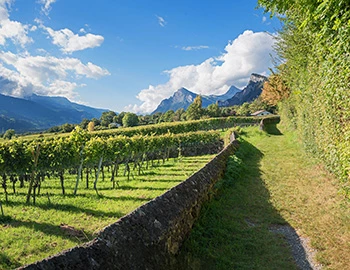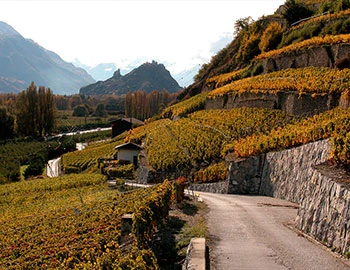1844 Ballenz rot 2022
Ostschweizer Landwein, Roland und Karin Lenz, 750 ml

| Grape variety: | Maréchal Foch, Léon Millot, Pinot noir |
| Producer: | Roland und Karin Lenz |
| Origin: | Switzerland / Ostschweiz |
| Other vintages: |
Description
In its cuvée from traditional Pinot Noir and incorporating some PIWI varieties, this most recent addition to the «Baur au Lac Vins and Lenz family» introduces itself as highly fragrant and fruity. With its aromas of blueberry, cherry and violet, the bouquet radiates cheerfulness. On the palate, it is fresh and drinkable with considerable juiciness, soft tannins and youthful delicacy. This Ballenz - preferably lightly chilled - inspires enjoyment as a soloist, with an aperitif riche, with tapas or even to accompany a meat platter.
Attributes
| Origin: | Switzerland / Ostschweiz |
| Grape variety: | Maréchal Foch, Léon Millot, Pinot noir |
| Label: | Vegan, Certified organic or biodynamic wine |
| Ripening potential: | 1 to 4 years |
| Drinking temperature: | 16 to 18 °C |
| Food Pairing: | Grilled fish, Spiced grillades, Orecchiette, Strozzapreti alla siciliana, Vegetable pie, Apéro riche |
| Vinification: | short must fermentation |
| Harvest: | hand-picking |
| Volume: | 12.5 % |
| Note: | Contains sulphites |
Pinot noir
Blueprint of the terroir
No other variety expresses its terroir as precisely as Pinot noir. It is a sensitive, fragile grape. But when it succeeds, it gives the world some of its very greatest wine plants. It especially excels in Burgundy, where it has been cultivated for at least 700 years. Even in the middle ages, it was considered so precious that it was kept separate from other grapes so as to not diminish its value. The finest examples are delicate and fragrant with aromas of cherries and red berries. With maturity, notes of forest floor, leather and truffles enter as well. An irresistible fruity sweetness still shines through, even after several decades. The Pinot noir does well in cool locations: in Switzerland and in Germany, where it is known as Blauburgunder and Spätburgunder respectively; in Alsace and in South Tyrol, in Oregon, New Zealand and Tasmania. Not least, it yields fantastic champagnes. It is a wonderful culinary companion. With its soft tannins and charming bouquet, it meshes with everything, from Güggeli and cheeses to fried fish.

Ostschweiz
Eastern Switzerland: an intriguing puzzle
Eastern Switzerland has long been positioned on the northern rim of the climate zone where the cultivation of popular Swiss varieties is possible. Due to a warming climate, the vineyards of Aargau, Zurich, Schaffhausen, Thurgau and Graubünden are now in the zone where varieties such as Müller-Thurgau or Pinot Noir succeed excellently. But even long-established, almost-forgotten varieties such as Elbling, Räuschling and Completer are experiencing a renaissance.

Switzerland
Switzerland – A small country with enormous diversity
Switzerland is famous for its banks, watches, and cheese, but not necessarily for its wine. The Swiss didn't invent wine, but they have been extremely open and curious to it. Wine culture arrived in what is now modern Switzerland via several routes: from Marseilles to Lake Geneva and the Lower Valais region; from the Aosta Valley through the Great St. Bernard Pass to the rest of Valais; from the Rhone through Burgundy, across the Jura Mountains to Lake Constance; and from Lombardy to Ticino, and then on to Grisons.



